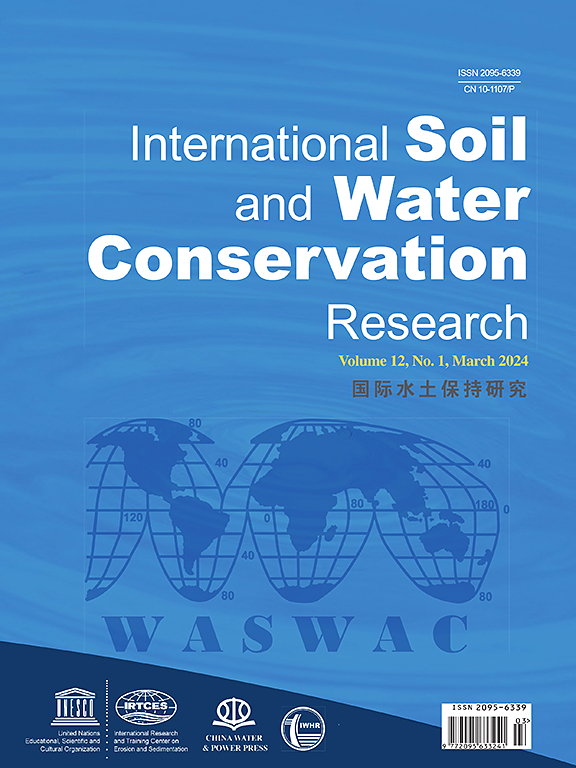含有猪粪的场地通过陆上片流进行的养分迁移
IF 7.3
1区 农林科学
Q1 ENVIRONMENTAL SCIENCES
International Soil and Water Conservation Research
Pub Date : 2024-04-13
DOI:10.1016/j.iswcr.2024.04.001
引用次数: 0
摘要
农业径流中的营养物质可能造成场外环境影响。本研究的目的是研究含有猪浆的场地上的地表流对养分的输送。本研究的数据是在美国内布拉斯加州东南部农田进行的野外降雨模拟试验中收集的。在实验地块的顶部以四个连续增量增加流入,以模拟在较大下坡距离发生的径流速率。试验点径流速率为2.3 ~ 21.2 L min - 1,最大等效下坡距离为5 ~ 108 m。磷(P)和氮(N)输运率随径流速率呈线性增加。使用学生t检验的假设检验证实了预测,即根据场地特定条件校准的线性方程可以用于将养分运输速率与径流速率联系起来。磷和氮的运输速率被认为受(a)在特定径流速率下猪浆释放的养分数量和(b)可用于运输释放的养分的地表流量的影响。如果养分运输速率能与径流速率相联系,就有可能将从小块地获得的实验结果外推到更大的下坡距离。现有的基于过程的模型用于沿丘陵地区的坡面流路线,也可以进行修改,以包括营养成分。本文章由计算机程序翻译,如有差异,请以英文原文为准。
Nutrient transport by overland sheet flow on sites containing swine slurry
Nutrients in agricultural runoff may cause offsite environmental impacts. The objective of this investigation was to examine nutrient transport by overland sheet flow on sites containing swine slurry. Data examined in this study was collected during field rainfall simulation tests conducted on cropland sites in southeast Nebraska, USA. Inflow was added to the top of experimental plots in four successive increments to simulate runoff rates occurring at greater downslope distances. Runoff rates on the experimental sites ranged from 2.3 to 21.2 L min−1 and maximum equivalent downslope distances varied from 5 to 108 m. Phosphorus (P) and nitrogen (N) transport rates were found to increase in a linear fashion with runoff rate. Hypothesis testing using the student’s t-test affirmed the prediction that a linear equation, calibrated for site specific conditions, can be used to relate nutrient transport rates to runoff rates. P and N transport rates were thought to be influenced by (a) the quantity of nutrients released by swine slurry at a particular runoff rate and (b) the amount of overland sheet flow available to transport the released nutrients. If nutrient transport rates can be linked to runoff rates, it may be possible to extrapolate experimental results obtained from small plots to greater downslope distances. Existing process-based models used to route overland sheet flow along hillslopes on upland areas could also be modified to include nutrient constituents.
求助全文
通过发布文献求助,成功后即可免费获取论文全文。
去求助
来源期刊

International Soil and Water Conservation Research
Agricultural and Biological Sciences-Agronomy and Crop Science
CiteScore
12.00
自引率
3.10%
发文量
171
审稿时长
49 days
期刊介绍:
The International Soil and Water Conservation Research (ISWCR), the official journal of World Association of Soil and Water Conservation (WASWAC) http://www.waswac.org, is a multidisciplinary journal of soil and water conservation research, practice, policy, and perspectives. It aims to disseminate new knowledge and promote the practice of soil and water conservation.
The scope of International Soil and Water Conservation Research includes research, strategies, and technologies for prediction, prevention, and protection of soil and water resources. It deals with identification, characterization, and modeling; dynamic monitoring and evaluation; assessment and management of conservation practice and creation and implementation of quality standards.
Examples of appropriate topical areas include (but are not limited to):
• Conservation models, tools, and technologies
• Conservation agricultural
• Soil health resources, indicators, assessment, and management
• Land degradation
• Sustainable development
• Soil erosion and its control
• Soil erosion processes
• Water resources assessment and management
• Watershed management
• Soil erosion models
• Literature review on topics related soil and water conservation research
 求助内容:
求助内容: 应助结果提醒方式:
应助结果提醒方式:


